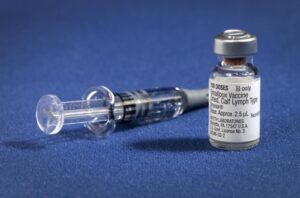10% Off COUPON CODE for New Customers: SAVE10
Viagra, Antibiotics, and Other Meds that Were Discovered Accidentally
Many medicines were invented during a long and painstaking work aimed at the development of a specific substance that must treat a certain disease. But some medicines or their effects were discovered quite by accident.
On this page:
Discovery of Sildenafil’s Anti-ED Effect
 This entertaining story is well-known. In the early 1990s, Pfizer scientists worked on a medicine for cardiovascular disease, but at the stage of clinical trials it was found that the drug did not provide a substantial cardiac action, but it had an unexpected and very interesting “side effects”. Some participants did not want to return the pills. It turned out that they had a significantly improved penile erection.
This entertaining story is well-known. In the early 1990s, Pfizer scientists worked on a medicine for cardiovascular disease, but at the stage of clinical trials it was found that the drug did not provide a substantial cardiac action, but it had an unexpected and very interesting “side effects”. Some participants did not want to return the pills. It turned out that they had a significantly improved penile erection.
After a lot of new research and safety checks in 1998, blue pills were released to the market, thus giving men and their partners a chance to renew their sexual relations. Viagra caused a real sensation in the market of anti-ED medications, because earlier there had not been such effective and easy-to-use tablets.
By the way, the Nobel Prize (a parody of the Nobel Prize), which is awarded annually to scientists for the most useless research, was awarded in 2007 to three Argentine researchers who found that sildenafil helped hamsters recover better after jet-lag.
Invention of Antibiotics by Fleming
In 1928, Alexander Fleming conducted a routine experiment during a long research devoted to the study of the human body’s struggle with bacterial diseases. The scientist had grown colonies of Staphylococcus bacteria and found that some cultivation cups were infected with ordinary Penicillium. It is a fungus due to which bread and other products acquire a green color with prolonged storage. The scientist noticed an area around the mold spots where there were no bacteria. Fleming came to the conclusion that mold produced a substance that suppressed bacteria. As a result, he developed a molecule now known as “penicillin.” It was the 1st antibiotic drug in the world. Thanks to antibiotics, the lives of tens of millions of people have been saved, and many diseases have become more treatable.
The principle of antibiotic work consists in inhibition or suppression of the chemical reaction necessary for the existence of a bacterium. Penicillin blocks the molecules involved in the construction of new bacterial cell membranes. It does not affect humans or animals, because the outer shells of their cells radically differ from bacterial cells.
Smallpox Vaccines – Accidental Invention of Edward Jenner
 In 18th-century Britain, vaccinations against smallpox were widely used, but they were associated with serious risks. The approach that existed at that time was called variolation and consisted in vaccination of small amount of pus, taken from ripe pustules of a person suffering from natural smallpox. 2 patients out of 100 died after that manipulation, because instead of an easy form of the disease, they experienced a severe one.
In 18th-century Britain, vaccinations against smallpox were widely used, but they were associated with serious risks. The approach that existed at that time was called variolation and consisted in vaccination of small amount of pus, taken from ripe pustules of a person suffering from natural smallpox. 2 patients out of 100 died after that manipulation, because instead of an easy form of the disease, they experienced a severe one.
One day young doctor Edward Jenner was talking to a milkmaid whose hands were covered with skin rashes. She said that that was not human smallpox but “smallpox of cows”. Jenner remembered that even in the midst of an epidemic, milkmaids had never been infected with human smallpox. The doctor infected an 8-year-old boy with cowpox, who developed a fever but no serious symptoms. After a while Jenner made the boy a traditional variolation, but the small patient did not get sick.
The technique was successfully tested in other patients. At first, other scientists were skeptical of Jenner’s method. But eventually such a vaccination was adopted. Thanks to Jenner’s discovery, vaccines against other diseases began to be invented and widely used.
Warfarin – From Killing Rats to Saving People’s Life
 The discovery of warfarin* is associated with the study of the sudden death of cattle in the US and Canada in the early 1920s. Animals died after minor injuries (such as the removal of horns or castration) due to a significant loss of blood. Sometimes fatal bleeding in animals occurred spontaneously. In 1921, Canadian veterinarian Frank Schofield when conducting autopsy discovered, that the dead cows had eaten the moldy silage from sweet clover. It turned out that spoiled clover contained an anticoagulant.
The discovery of warfarin* is associated with the study of the sudden death of cattle in the US and Canada in the early 1920s. Animals died after minor injuries (such as the removal of horns or castration) due to a significant loss of blood. Sometimes fatal bleeding in animals occurred spontaneously. In 1921, Canadian veterinarian Frank Schofield when conducting autopsy discovered, that the dead cows had eaten the moldy silage from sweet clover. It turned out that spoiled clover contained an anticoagulant.
However, warfarin was initially underestimated and used as a rat poison. It began to be produced in 1948. Small doses of this substance caused bleeding in rats. Initially, it was believed that the medicine was dangerous for people. However, later scientists discovered that warfarin had anticoagulant properties and could be used by people for blood thinning and treating thrombosis. In the mid-1950s warfarin began to be prescribed to people. Thus, rat poison had become one of the most popular blood thinners in the world.
* For more information about Coumadin (Warfarin), please visit this page: /products/cholesterol/coumadin/
Some Antidepressants
Some types of antidepressants were discovered accidentally.
For example, ironiazide was originally used to treat tuberculosis in the mid-20th century, however, doctors found that it also had an antidepressant effect, as some individuals exhibited euphoria. Tricyclic antidepressants (amitriptyline, doxepin, and others) were originally tested for the treatment of schizophrenia.